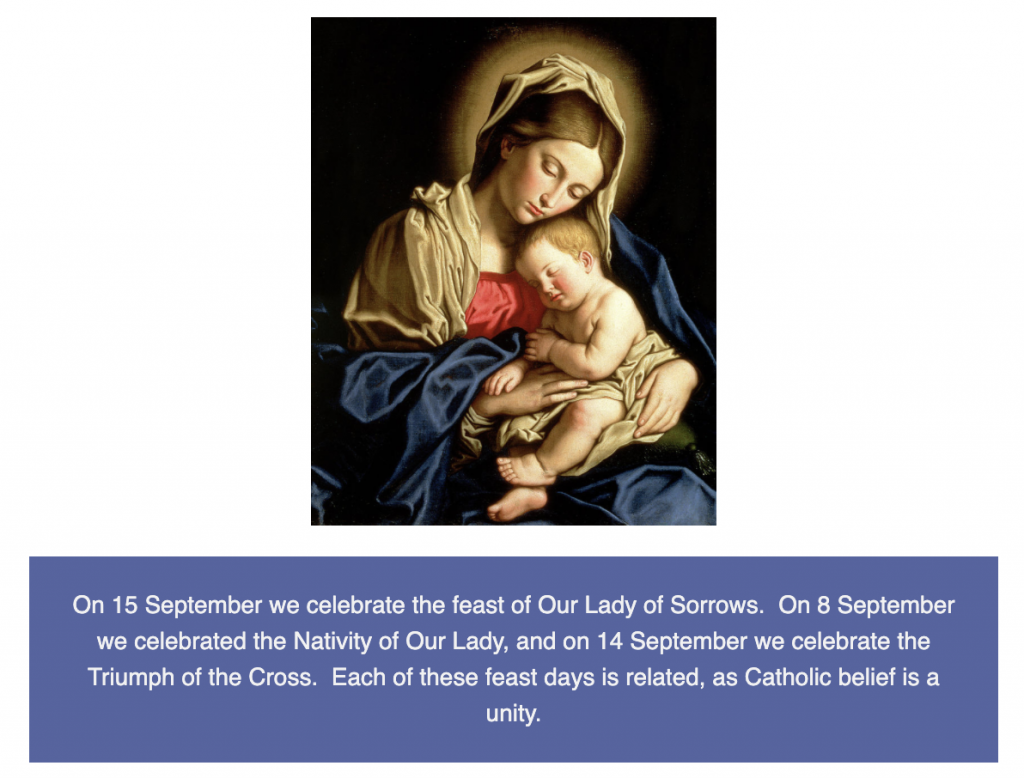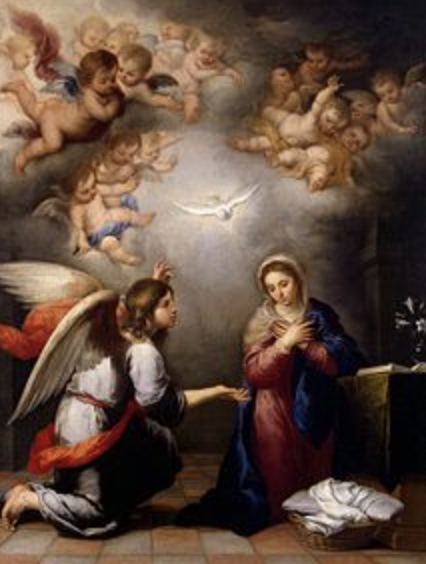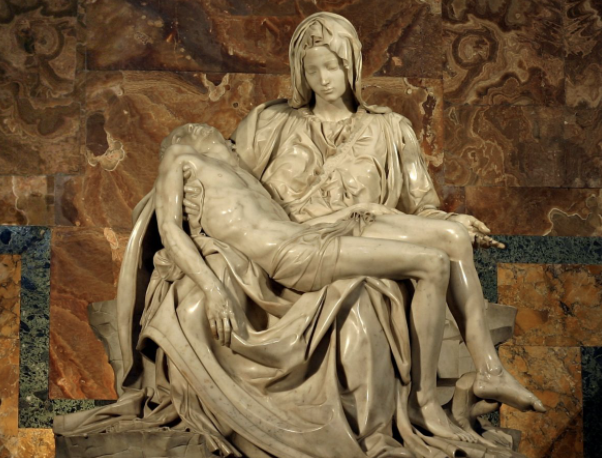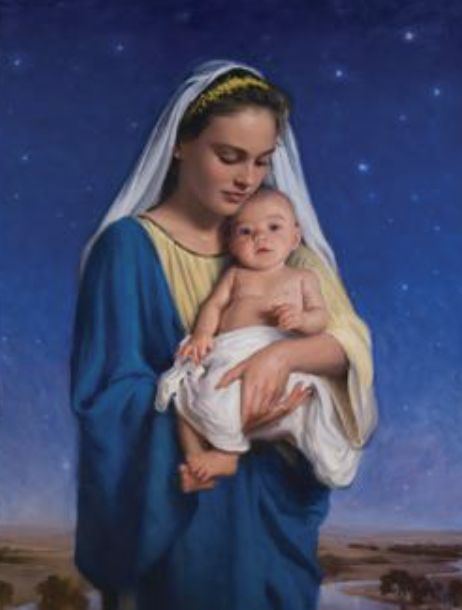
What Do We Know?
What do we know of Our Lady? Some say not much, but others say quite a lot, drawn from Scripture, especially the Gospel of St Luke, also drawn from what we know of Jewish life in Israel at the time of Jesus of Nazareth, and, finally, drawn from prayer and reflection over the past two thousand years.
Woman of Paradox
Mary is a woman of paradox. She is a virgin, and yet she is a mother. She is the mother of just one child, and yet she is the mother of us all. She lived in obscurity, and yet she is the best-known woman in history. She was totally submissive to God’s will, and yet she is the most powerful woman in history. She was enveloped in the Jewish culture of her day, and yet she is a woman for all times, all places, all circumstances. She is a woman, and shows what it is to be a woman, and yet she also shows what it is to be a man. Her life was full of sorrow, and yet full of joy…
New Eve
We are provided with interpretative “keys” to the life of Our Lady from what we call the Old Testament. Our Lady is the New Eve. Just as Eve, with her rejection of God’s will, brought death for all mankind, so Mary, with her “yes”, became a cause of salvation for herself and for all. Mariology takes its direction from Christology. By her compassion, both for her Son, so vividly depicted in images of the Pieta, and for all, Mary is the mother, not only of Christ, but of all. In contrast to Eve, Mary is totally responsive to God. “Behold, I am the handmaid of the Lord; let it be done to me according to your word. ” Mary makes the Incarnation more human, more accessible for us.
St Bernard of Clairvaux
St Bernard of Clairvaux points out that after the sin of our first parents, the whole world was shrouded in darkness, under the dominion of death. Now God seeks to enter the world anew. He knocks at Mary’s door. He needs human freedom. The only way he can redeem man, who was created free, is by means of a free “yes” to his will. So, Bernard portrays heaven and earth holding its breath at the question asked by the angel Gabriel to Mary. Will she say yes? Will Mary’s humility hold her back? Bernard urges – do not be humble but be daring! This is the moment of free, humble, yet magnanimous, obedience.

Mother of God
And Mary becomes the Mother of God through her “yes”. Mary is the Ark of the Covenant, carrying in her womb God himself, Jesus who saves. As the Apostles Creed proclaims – Jesus was born of the virgin Mary – as the Niceno Constantinopolitan Creed proclaims – For us men and our salvation he came down from heaven, by the power of the Holy Spirit he was born of the Virgin Mary, and became man – and as also the Council of Ephesus in 431 proclaimed – Mary is not only the Mother of Jesus, but also Theotokos, the Mother of God.
Holy Innocents
Mary is Our Lady of Sorrows, having fled from the homicidal King Herod who murdered the infant boys of Bethlehem in search for the Messiah. Herod did not understand that the kingdom of the Messiah was not of this world, and posed no direct threat to his tyranny. The massacre of the Holy Innocents is entirely consistent with what we know of Herod, who murdered various members of his own family, and many others, as recounted by the near contemporary Jewish historian Josephus.
Seat of Wisdom
Mary kept all these things – the annunciation of the angel Gabriel, the birth of Jesus, the presentation of the child Jesus in the Temple, the flight into Egypt, Jesus being lost, and later found with the teachers in the Temple – pondering all these things in her heart. Mary is an exemplar of the contemplative life. With Mary we are asked to ponder the life of Christ, the action of God, in our heart. She is the Seat of Wisdom.
Solace of Migrants
It is not surprising that Pope Francis has included in the Litany a new intercession, “Solace of Migrants”. Mary and Joseph, and the infant Jesus, fled from Bethlehem to Egypt where they lived for some time before returning to Nazareth in Galilee. Pope Francis has also added the intercessions – Mother of Mercy and Mother of Hope. The Litany of the Blessed Virgin Mary was originally approved by Pope Sixtus V.
Observant
We know that the Holy Family were “observant” Jews, living according to Jewish law. We also know that Mary knew and understood what we call the Hebrew Bible very well. We know this from considering the Magnificat which is redolent with imagery from the Hebrew Bible. Aramaic was the language of what we call the Middle East, including the language of the Jews. But Jewish scriptures were written in Hebrew, so it is likely that Mary understood Hebrew.
Woman of the World
The Jews of the diaspora used the Septuagint which had been translated into Greek. Having lived in Egypt for some time, Mary may also have known Greek. There was an extensive Greek-speaking Jewish diaspora throughout the known world, most notably in the Egyptian city of Alexandria on the Mediterranean. The Greek version of the Hebrew Bible used by the Greek-speaking Jewish diaspora is called the Septuagint. Even in Galilee, there were Greek-speaking towns and cities – and Greek was the language of commerce, and of high culture. What we call the New Testament would be written in Greek, the lingua franca of much of the known world. Mary was a woman of the world in that she was familiar with the language and culture, not only of observant Jews, but of the Greeks, the conquering Romans, and of the Egyptians amongst whom she had lived as a refugee.
Calling a Spade A Spade
We know that Mary was a down to earth practical person, calling a spade a spade. This is consistent with her response to the angel Gabriel: “How shall this be, since I have no husband?” Similarly, Mary’s laconic observation to Jesus at the wedding in Cana: “They have no wine.”
Do Whatever He Tells You
But consistent with her own complete submission to the will of God – she listens to the word of God and keeps it – Mary says at Cana, at the commencement of Jesus’ public life: “Do whatever he tells you.” This is aligned with Jesus’ words: “Who are my mother and brethren? Here are my mother and brethren. Whoever does the will of God is my brother, and sister, and mother.” Mary is a model of self-giving and self-forgetfulness.
Foot of the Cross
We know from St John that Mary was at the foot of the Cross. Christ said to St John, “Behold your mother”, and to Mary, “Behold your son”. After the Ascension, the Apostles devoted themselves to prayer, together with the women and Mary, the mother of Jesus, and with his brethren. So, Mary is the Mother of the Church.

Stabat Mater
Mary’s presence at the crucifixion of her Son confirms the prophecy of Simeon in the Temple “and a sword shall pierce your heart”. Our Lady of Sorrows is highlighted in the medieval poem, the Stabat Mater:
At the Cross her station keeping,
stood the mournful Mother weeping,
close to Jesus to the last;
Through her heart, His sorrow sharing,
all His bitter anguish bearing,
now at length the sword has passed.
Oh how sad and sore distressed
was that Mother, highly blest,
of the sole-begotten One!
Christ above in torment hangs,
she beneath beholds the pangs
of her dying glorious Son.
Is there one who would not weep,
whelmed in miseries so deep,
Christ’s dear Mother to behold?
Can the human heart refrain from partaking in her pain,
in that Mother’s pain untold?
Bruised, derided, cursed, defiled,
She be beheld her tender Child,
All with bloody scurges sent
For the sins of His own nation,
Saw Him hang in desolation,
Till His spirit forth He sent.
O you Mother! fount of love!
Touch my spirit from above,
make my heart with yours accord:
Make me feel as you have felt;
make my soul to glow and melt
with the love of Christ my Lord.
Holy Mother, pierce me through,
in my heart each wound renew
of my Saviour crucified.
Let me share with you His pain,
who for all our sins was slain,
who for me in torments died.
Let me mingle tears with you,
mourning Him who mourned for me,
all the days that I may live:
By the Cross with you to stay,
there with you to weep and pray,
is all I ask of you to give.
Virgin of all virgins blest,
Listen to my fond request:
let me share your grief divine;
Let me, to my latest breath,
in my body bear the death
of that dying Son of yours.
Wounded with His every wound,
steep my soul till it has swooned,
in His very Blood away;
Be to me, O Virgin, nigh,
lest in flames I burn and die,
in His awful Judgment Day.
Christ, when you call me hence,
be your Mother my defence,
be your Cross my victory;
While my body here decays,
may my soul your goodness praise,
Safe in Paradise with You.
The Stabat Mater was written in the 13th century by the Franciscan Friar, Jacopone De Todi (1230-1306) or by Pope Innocent III. The title comes from the first line “Stabat Mater Dolorosa.” There are more than 60 English translations. The Stabat Mater has been set to music by many composers – for instance, Palestrina, Verdi, Rossini, Schubert, Dvorak. The Stabat Mater is an illustration of the close connection between western culture and the Blessed Virgin Mary.

No Other Children
Our Lord’s entrusting of Mary to St John is consistent with St Joseph having died, and with Mary having no other children, she being a virgin. It is sometimes objected that the reference to Jesus’ “brothers” indicates that Mary and Joseph had other children. Certainly, the New Testament often mentions Jesus’ brethren. The so-called brethren of Jesus are his relatives but not children of Mary. Scott Hahn and Curtis Mitch argue that four observations support the Church’s tradition: (1) These brethren are never called the children of Mary, although Jesus is. (2) Two brothers mentioned, James and Joseph, are sons of a different Mary in Mt 27:56. (3) It is unlikely that Jesus would entrust his Mother to the Apostle John at his Crucifixion if she had other natural sons to care for her. (4) The word “brethren” has a broader meaning than blood brothers. Since ancient Hebrew had no word for “cousin”, it was customary to use “brethren” in the Bible for relationships other than blood brothers.
Cosmic Significance
The cosmic significance of the life of Mary is exemplified in the Apocalypse where a great sign appears in heaven, a woman clothed with the sun, with the moon under her feet, and on her head a crown of twelve stars; she was with child and she cried out in her pangs of birth, in anguish for delivery. What are we to make of this symbolic language? Certainly, good biblical commentary can help us pierce the symbolism, but beyond such explanations is mystery, part of Christian belief and life.
Devotion to Our Lady
Devotion to Our Lady is not some charming “add on”, but integral to our lives as Christians. The Hail Mary, second only to the Our Father, expresses all that is to be said of our life as wayfarers in this valley of tears. Prayers such as the Angelus and Regina Coeli, as well as the Hail Holy Queen (Salve Regina) and Memorare provide a Marian dimension to ordinary life. Shrines such as Lourdes, Fatima, Loreto, Guadalupe and Czestochowa are a manifestation of popular resort to Our Lady. A counterpart to popular piety is the enormous number of artistic masterpieces devoted to Mother and Child, as well as the more mundane cribs which, to date, the commissars of correctness have failed to eliminate from places where Christians live. When Pope Francis speaks to us on some topic, however apparently remote, he commonly concludes by referring to Our Lady, a reminder that there can be no Christian life without Mary.
Our Lady of Sorrows
Our Lady of Sorrows whose feast we celebrate on 15 September complements our understanding of the life of Christ.
Michael McAuley
